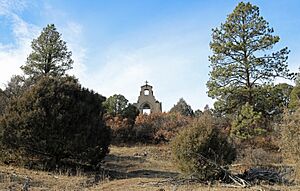Morley, Colorado facts for kids
Morley was a small town in Las Animas County, Colorado, that existed for about 78 years, from 1878 to 1956. It was located high up near a mountain pass called Raton Pass. Morley started as a stop for trains, but it soon became a busy town where people mined coal. The Colorado Fuel and Iron Company (CF&I) owned the town and the coal mine. Morley was a "company town" for 50 years until the mine closed, and the town was taken down.
Contents
History of Morley
How Morley Started
The area where Morley was built was first called Cima by Spanish traders. This word means "summit" or "high place." In 1878, the Santa Fe Railroad Company made it a stop for trains. They also built homes for their workers there. Later, in 1906, the Colorado Fuel and Iron Company (CF&I) took over the land. They wanted to mine coal from the ground.
Life in a Company Town
The coal mined in Morley was sent north to CF&I's big steel factory in Pueblo, Colorado. CF&I owned almost everything in Morley. Most people living there either worked for CF&I or were related to someone who did.
At its busiest in the 1920s, Morley had over 600 residents. It had its own post office, a school, and a church. The mine dug up about 600 tons of coal every day. By the time it closed, it had produced over 11 million tons of coal. This coal was used to make steel and to power steam-powered Santa Fe Railroad trains. It also helped make electricity and run machines in the town.
Why the Mine Closed
Around 1949, CF&I leaders started thinking about closing the mine. The amount of coal they were finding had dropped a lot. Also, arguments with workers made it more expensive to run the mine. It was also costly to feed and care for the many mules used in the mine. For example, nearly 150 mules worked there. Each mule ate over 10 pounds (4.5 kg) of oats and a bale of hay every day. Using electric machines, like in other mines, was much cheaper.
The End of Morley
CF&I began letting workers go in 1950. By 1955, only about 24 workers were left. The local school closed that year. Students then had to ride buses to Trinidad, which was 20 miles away.
Finally, in 1956, the mine closed for good. CF&I tore down all the company buildings. They did not want to be responsible if people tried to live in them. However, they left the old St. Aloysius Catholic Church standing. The workers felt it was wrong to tear down a holy place. Parts of the church ruins can still be seen today. Most of the former workers and their families moved to Trinidad or to Raton, New Mexico.
Morley Today
Today, a major highway (Interstate 25/U.S. Highway 87) and the Santa Fe/Amtrak train tracks run past where Morley used to be. Some ruins can still be seen. The most famous ruin is the old St. Aloysius Church. It has a Spanish colonial style bell tower.
In 2011, a group wanted to buy the land where the town and church stood. They hoped to rebuild the church and part of the town as a tourist spot. They planned a coal mining museum and shops that would show what life was like in the 1920s. But people living nearby did not like the idea. They did not want visitors disturbing the quiet area.


